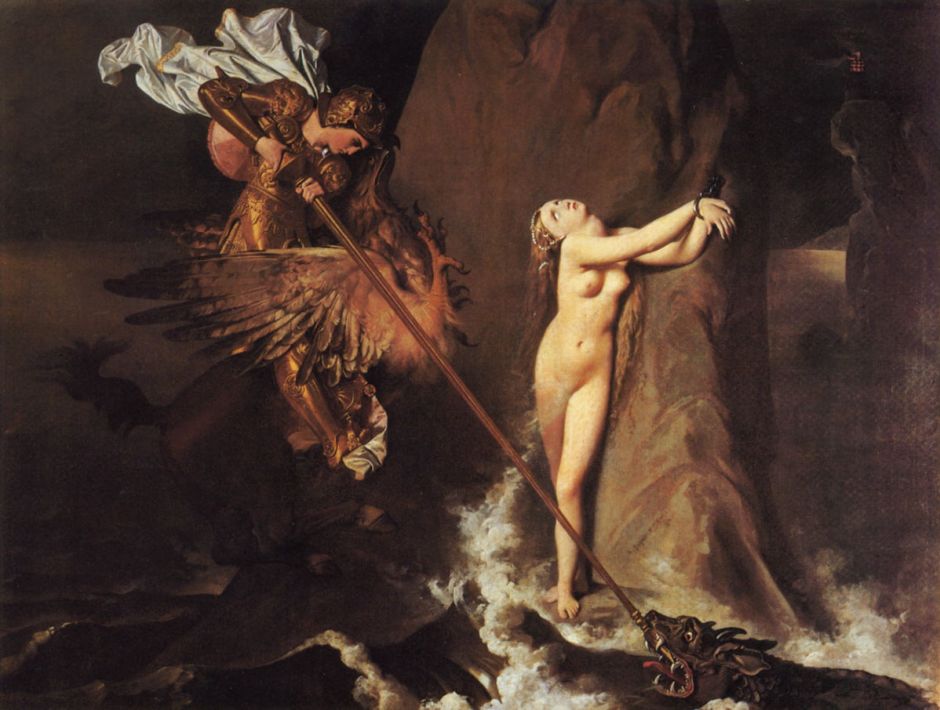Eugène Delacroix started painting at a challenging time. Apart from the dramatic political changes that brought first the Napoleonic Wars, Napoleon as Emperor in 1804, his abdication and exile a decade later, then the Bourbon Restoration, painting was on the change as well.

The dominant Neoclassical style of Jacques-Louis David was on the wane. With the end of Napoleon’s empire, David had been put on the list of proscribed individuals, and had gone into self-exile in Brussels. Following his death at the end of 1825, only his heart was allowed to return to France for burial. Delacroix described David’s The Intervention of the Sabine Women (1799) as “earthy, bleak and lifeless”.

Delacroix’s teacher from 1815 was Pierre-Narcisse Guérin, whose style Delacroix openly disliked. Rubens was his preferred model for his emphasis on colour, in contrast to David and Guérin who rated line and draughtsmanship more highly.

Of the older generation, it was perhaps Pierre-Paul Prud’hon who had greater appeal, although Delacroix would have been too young to have seen his depiction of Nemesis in Justice and Divine Vengeance Pursuing Crime at the Salon in 1808.

Delacroix became an enthusiast for the landscape paintings of John Constable, and they proved influential early in his career.
When Constable’s The Hay Wain (1821) attracted little attention at the Royal Academy in London, and still failed to sell the following year at the British Institution, it was the French dealer John Arrowsmith who introduced the British artist’s paintings to the French market. On 19 June 1824, after Arrowsmith had bought The Hay Wain, A View on the Stour near Dedham (1822) and a small seascape of Yarmouth Jetty and exhibited them in Paris, Delacroix studied Constable’s technique.
As a result, Delacroix hastily repainted his Scenes from the Massacres at Chios (1824) immediately before it was shown at the Salon that year, in which The Hay Wain was awarded a gold medal.

If any single painting proved the greatest inspiration to Delacroix it was Géricault’s huge The Raft of the Medusa (1818-19), and the two artists formed a close friendship that only ended with the early death of Géricault in 1824.

One of Géricault’s last paintings was of Mazeppa (1823), a story that appealed to Delacroix’s generation.

Three years later, Horace Vernet painted Mazeppa and the Wolves (1826) based on the same poem by Lord Byron.

Delacroix and Vernet avoided painting competing motifs, but in this case, the younger Delacroix had already painted a different scene, of Mazeppa on the Dying Horse in 1824.

Ary Scheffer was another history painter in the ascendant as Delacroix was establishing himself; although the two overlapped slightly at times, any borrowing was on Scheffer’s part. They shared friendship with the declining Géricault, and it was Scheffer’s tribute on The Death of Théodore Géricault (1824) that forms the painted record.

Delacroix had great respect for the work of another, more contemporary British painter, Richard Parkes Bonington, sufficient to share his studio with him. Bonington painted this Knight and Page (Goetz von Berlichingen) when they were sharing in early 1826, and left it incomplete with Delacroix when he moved out. As with Géricault, Bonington was to die early, just two years later.

Léon Cogniet was another important contemporary and friend, with whom Delacroix had common ground, as seen in Cogniet’s Massacre of the Innocents from 1824.
If Delacroix had a rival, it was the senior figure of JAD Ingres, with whom he competed for public commissions.

Ingres first painted Oedipus and the Sphinx in 1808, just two years after he had arrived in Rome as the recipient of the Prix de Rome. When sent back to Paris, it was criticised over its treatment of light, and lack of idealisation in the figures. In 1825, Ingres decided to develop it into a more narrative work, which he completed in 1827. This time it was well received.

More typical for Ingres is his treatment of Roger (Ruggiero) Rescuing Angelica, painted in 1819, depicting this scene from Ariosto’s Orlando Furioso. This was purchased for King Louis XVIII and was installed in the Palace of Versailles the following year.
References
Barthélémy Jobert (2018) Delacroix, new and expanded edn, Princeton UP. ISBN 978 0 691 18236 0.
Patrick Noon and Christopher Riopelle (2015) Delacroix and the Rise of Modern Art, National Gallery and Yale UP. ISBN 978 1 857 09575 3.
Lucy Norton (translator) (1995) The Journal of Eugène Delacroix, 3rd edn, Phaedon. ISBN 978 0 7148 3359 0.
Arlette Sérullaz (2004) Delacroix, Louvre Drawing Gallery, 5 Continents. ISBN 978 8 874 39105 9.
Beth S Wright (editor) (2001) The Cambridge Companion to Delacroix, Cambridge UP. ISBN 978 0 521 65077 1.

